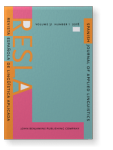Vol. 31:1 (2018) ► pp.1–31
Vol. 31:1 (2018) ► pp.1–31
The acquisition of voicing assimilation by advanced Hungarian learners of Spanish
This study examines the effect of explicit phonological instruction on the acquisition of variable /s/ voicing in Spanish by advanced Hungarian learners. Hungarian and Spanish have very similar, yet not identical, voicing assimilation (VA) systems; the most important difference lies in the pre-sonorant context as sonorant consonants trigger voicing assimilation in Spanish but not in Hungarian. Data were collected in acoustic experiments from 7 native speakers of Northern Peninsular Spanish and 12 Hungarian university students who were advanced learners of Spanish. The latter group was tested twice: before and after a three-month Spanish phonetics and phonology course. Our data reveal that this amount of instruction is not enough for L2 speakers to overcome their first language VA system, which might be attributed, in part, to the variable allophonic nature of the process and the similarity between the two languages’ VA systems.
Article outline
- 1.Introduction
- 2.Background
- 2.1Regressive voicing assimilation in Hungarian
- 2.2/s/ voicing in Spanish
- 2.3Pronunciation instruction and L2 acquisition
- 2.4From L1 Hungarian to L2/FL Spanish pronunciation
- 3.Methodology
- 3.1Participants
- 3.2Stimuli
- 3.3Instruction period
- 3.4Testing procedure
- 3.5Statistical analysis
- 4.Results
- 4.1Expected voiceless realisations
- 4.2Voicing context
- 5.Discussion
- 5-1Coarticulatory /s/ voicing by native Spanish speakers
- 5.2Learning pre-sonorant voicing
- 6.Conclusions
- Acknowledgements
-
References
